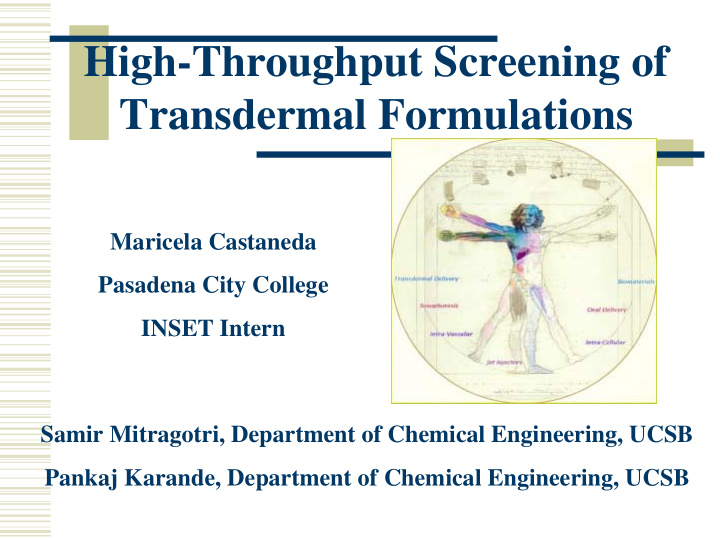



High-Throughput Screening of Transdermal Formulations Maricela Castaneda Pasadena City College INSET Intern Samir Mitragotri, Department of Chemical Engineering, UCSB Pankaj Karande, Department of Chemical Engineering, UCSB
Abstract Transdermal drug delivery, although efficient, is limited by skin’s low permeability. Over 300 chemical enhancers have been found to enhance skin permeability but only a few are used in industry. A synergistic effect caused by two or more of these chemical enhancers may increase permeability. Use of a high throughput method enables many chemical formulations to be screened rapidly. By the application of chemical formulations on top layers of skin, subsequent application of an electric field enables the measurement of the change in the skin’s conductivity. With these experiments will we be able to discover more effective enhancer formulations and gain a better understanding of the effects of the enhancers on skin permeability. Work Cited K.A. Walters. “ Penetration Enhancers and their Use in Transdermal Therapeutic Systems.” Transdermal Drug Delivery: Developmental Issues an Research Initiatives, (1989) pp. 197-233 N. Kanikkannan,K. Kandimalla, S. S. Lamba, M.Singh. “Structure-Activity Relationship of Chemical Penetration Enhancers in Transdermal Drug Delivery.” Current Medicinal Chemistry,(2000) 7(6): 593-608 B. C. Finnin and T.M. Morgan. “Transdermal Penetration Enhancers: Applications, Limitations and Potential.” Journal of Pharmaceutical Sciences, (1999) 88(10): 955-958
Background Transdermal Drug Delivery, an alternative drug delivery method, is the absorption of a drug through the skin. This method has been study for a long time because of it’s advantages. It is more efficient in delivering the drug, no pain is involved, and it is patient- friendly.
The Challenge The problem with this method corresponds to skins low permeability. The topmost layer of the skin, stratum corneum (SC), consist of 10 layers of keratinocytes and the spaces between them are filled with lipid bilayers. A substance would have to diffuse through more than 100 densely packed lipid bilayers to cross the first layer of the skin.
LIPID BILAYERS STRATUM CORNEUM 23 µ m 1 µ m µ µ 15 15 m m EPIDERMIS HAIR 5 µ m FOLLICLE KERATINOCYTE DERMIS
Materials and Methods 300 chemical enhancers have been found to increase transdermal delivery. Combinations of these enhancers are likely to be more efficient in enhancing skin permeability then individually. So two chemical enhancers are combined in different amounts to make 44 different formulations. Since there is an abundant amount of formulations, a high-throughput (HTP) method is used to study the synergistic effect of these enhancers.
Materials and Methods High-throughput (HTP) screening is the ability to screen many test in a short amount of time. By using a HTP method, we can test many enhancer combinations in a short amount of time. The device used in the experiment was two plexi- glass plates that sandwiches the skin. The top plate has many holes where the formulations are placed. An electrical field is applied across the skin and the skin conductivity is measured.
High-Throughput Screener Drug reservoir Skin
Experimental Set-up
Results Activity Concentration Graph 2 .0 Total Surfactant Conc. (w/v %) 1 .8 1 .6 Total surfactant conc 1 .4 1 .2 1 .0 0 .8 0 .6 0 .0 0 .2 0 .4 0 .6 0 .8 1 .0 SLS wt Fraction S L S w t fra c tio n 0 0 15 15 15 0 F ig u re 2 C
Discussion In the results, the graph shows the conductivity of SLS:DPC. Blue represents low conductivity and red represents high conductivity. Conductivity enhancement was highest around 1.5 % of total enhancer concentration and SLS wt. Fraction of 0.5.
Acknowledgements Mentor: Pankaj Karande PI: Samir Mitragotri UCSB Chemical Engineering Department INSET Program Juvenile Diabetes Foundation Centers for Disease and Prevention The Whitaker Foundation
Recommend
More recommend